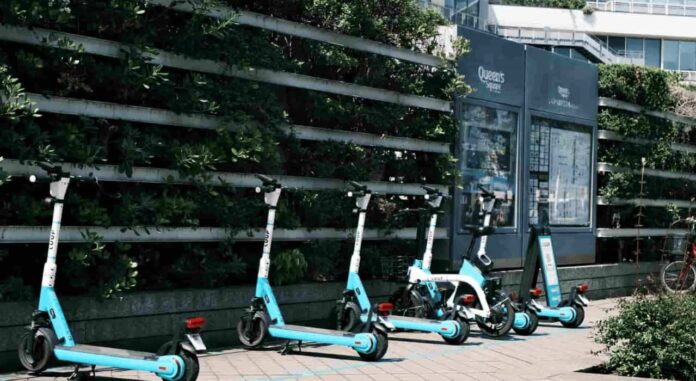The “Plus One Mile” Problem Solved
For those of you working, living or traveling in major Japanese cities like Tokyo or Osaka, how do you manage that last mile journey—the one to two-kilometer gap between the station/bus stop and your final destination?
-
- Trains and buses often take a roundabout route.
- Taxis are expensive and not ideal for daily use.
- Shared bicycles are great, but ports are often hard to find.
This common urban dilemma—a distance too far to walk but too short for conventional transport—is the “Last Mile Problem.” A new solution is rapidly spreading across Japan: the electric micro-mobility sharing service, Luup.
In this article, we provide a guide for busy foreign workers on the basics, benefits, and safe usage of Luup, making your urban life in Japan smoother and more convenient.
What is Luup? Japan’s New Mode of Transport
Luup is a sharing service featuring electric assist bicycles and, more notably, electric scooters.
Unmatched Port Density and Convenience
The key difference between Luup and traditional Japanese shared cycling services is the sheer number of Ports (parking, rental, and return spots) and the ease of use. Ports are strategically located near convenience stores, office buildings, and commercial facilities. With just the app, you can rent almost anywhere and return almost anywhere.
No Driver’s License Required After 2023 Law Change!
A major update to Japanese traffic laws in July 2023 simplified the usage of certain electric scooters. Luup’s specific e-scooter models can now be used under the following conditions:
- Driver’s License: Not required (Must be 16 years or older).
- Helmet: Recommended (Effort obligation).
- Max Speed: 20 km/h (on roads/bike lanes) or 6km/h (on special sidewalks).
Benefits of Luup for Foreign Workers
Luup offers significant advantages, especially for foreign residents navigating Japanese city life.
1. Optimizing Commute & Travel Time
-
- Save precious morning time by taking the shortest route on the road, bypassing time-consuming bus routes or long walks.
- Ports are highly concentrated in major business and residential areas (Shibuya, Shinjuku, Osaka Umeda, Nagoya, etc.), making it easy to find one near your work or home. 👉Check the Ports on the Luup site
2. Post-Last Train Mobility
-
- Japan’s last trains often run early, and taxis are expensive. Luup offers a cost-effective way to travel that “extra distance” late at night.
3. Low Language Barrier
-
- The app interface is intuitive and simple. Multilingual support is also being developed, allowing you to start using the service with minimal stress, even if you are not comfortable with Japanese.
Luup Pricing and Cost-Effectiveness
Luup’s pricing structure shines when used for short-duration, short-distance trips.
| Pricing Structure | Details |
| Base Fee | A fixed charge applied when you start a ride. |
| Time Fee | A per-minute charge for the duration of the ride. |
【Estimated Cost】 While rates can vary by region and campaign, a 10-minute ride typically costs around 200 to 250 yen.
Cost Comparison
| Mode of Transport | Estimated Cost for 1.5km (Approx. 10-min ride) |
| Luup (E-Scooter) | 200 to 250 yen approx. |
| Taxi (Minimum Fare) | 500 to 600 yen approx. (Varies by region) |
| Bus/Train | 180 to 220 yen approx. (Plus walking time/transfer hassle) |
Luup is a highly cost-effective and time-saving solution, especially for those awkward short distances where public transport is inconvenient. Payment is primarily done via Credit Card.
※Rates are subject to change. Always check the Luup app for the latest and most accurate pricing information.
How to Use Luup: Step-by-Step Guide
Here is how to get started, from app registration to beginning your ride.
| Step | Description | Requirements |
| 1. Download & Register | Download the Luup app and register your name and email. | Smartphone |
| 2. Identity Verification | You must upload your credit card information and a form of ID (Residence Card, Passport, etc.) to prove you are 16 or older. | Credit Card, ID |
| 3. Traffic Rule Test | If using the electric scooter for the first time, you must pass an online test on Japanese traffic rules. | 100% correct score required |
| 4. Reserve & Ride | Check the map for nearby ports and available vehicles, then reserve. Scan the QR code to unlock the vehicle. | – |
| 5. Return | Return the vehicle to any Luup Port near your destination. Take a photo in the app to confirm safe parking and end the ride. | Must return to a designated Port |
Essential Traffic Rules for Safe Riding
When riding the Luup e-scooter, you must adhere to Japanese traffic laws. Penalties apply for violations, so pay close attention to these rules.
| Rule | Details |
| Where to Ride | You must ride on the far left side of the roadway (car lanes). Bike lanes are also permitted. |
| Sidewalk Riding | Only permitted on sidewalks with special signage. When riding on a sidewalk, you must slow down to walking speed (6 km/h or less) and prioritize pedestrians. |
| Turning Right | At intersections, you must perform a two-step right turn (do not turn from the right side of the road; proceed across, stop, and then turn). |
| Prohibitions | Drunk driving, tandem riding (two people), and using a smartphone while riding are strictly prohibited. |
Luup is a fantastic tool that can significantly upgrade your life in Japan. Ensure you follow all the rules to enjoy safe, convenient, and fun urban mobility!
For more articles👇👇👇
📩 Subscribe to the Newsletter















